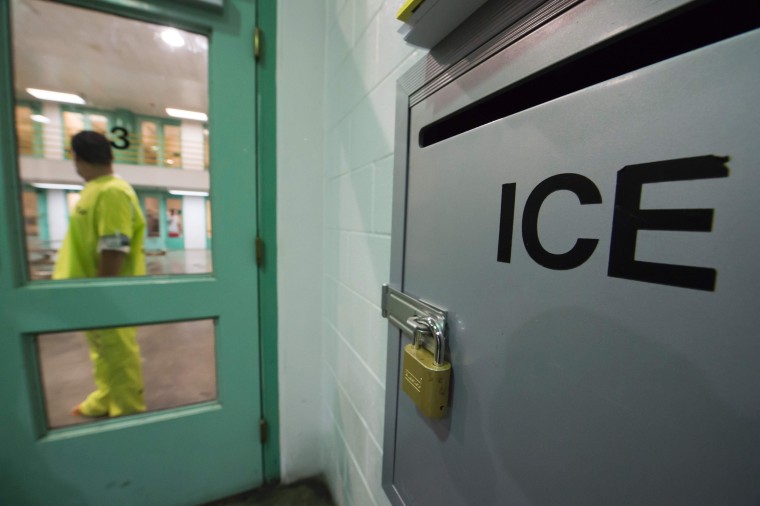Immigration and Customs Enforcement deportation officers are overburdened, under-trained and unaware of department-level deportation priorities, a government watchdog found.
The Department of Homeland Security’s inspector general, in an April 13 report released publicly Thursday, found that ICE deportation officers in charge of “non-detained” immigrants facing deportation at four ICE field offices were responsible, on average, for supervising between 1,700 and roughly 10,000 immigrants.
Caseloads for deportation officers overseeing detained immigrants were far less burdensome, averaging between 65 and 104 immigrants per person.
Supervisory staff told inspectors the caseloads were assigned arbitrarily.
Related: ICE Suspends Weekly ‘Sanctuary City’ Report Over Accuracy Concerns
“ICE is almost certainly not deporting all the aliens who could be deported and will likely not be able to keep up with growing numbers of deportable aliens," the report said.
In a statement to NBC News, acting ICE press secretary Jennifer D. Elzea said the agency agreed with the recommendations outlined in the report, which include a call to review staffing for detained and non-detained units, adding that due to their scope, the agency expects the changes to be implemented in early 2018.
"ICE remains committed to implementing safeguards to ensure that its deportation operations are executed in a way that promotes public safety and protects our communities," Elzea said. "ICE continues to strengthen and improve relationships with state and local law enforcement partners and to work directly with both foreign governments and with other government entities to improve cooperation with countries with whom we have encountered challenges in the past regarding repatriating their nationals."
“You might work 18 hours a day, but you still won’t get caught up."
According to the report, conducted as a follow up to a previous inspection requested by Congress, ICE neither collected nor analyzed workload data to determine how to balance officer workloads. Deportation officers supervising non-detained immigrants often did not have the time to obtain travel documents needed to deport an immigrant living in the country illegally.
ICE officers were also at times too overworked to conduct background checks every time an immigrant checked in with the field office. In at least one case, workloads limited ICE oversight of non-detained immigrants the agency had flagged as risks to national security, the report said.
“You might work 18 hours a day, but you still won’t get caught up,” one deportation officer working the non-detained docket told inspectors.
Related: ICE Says California Immigration Raids Planned Before Trump Orders
Inspectors also found the agency often failed to issue up-to-date, comprehensive procedures for supervising the more than 2.3 million immigrants on its non-detained docket, close to 2 million of which are non-criminal, Elzea said.
ICE staff told inspectors they received insufficient training, and about 2,900 immigration enforcement agents were transferred to deportation officer positions without proper instruction, the IG report added.
ICE training materials, including those on deportation priorities, were not clearly communicated to deportation officers, the investigation revealed. Often, the materials had gone years without being updated.
Though the agency concurred with all five of the IG’s recommendations, which, among other things, called for a standardized training curriculum and increased cooperation with the State Department, the agency’s problems could get worse as immigration enforcement amps up under the Trump administration.
According to data ICE provided to NBC News, the department arrested 21,362 in the first weeks of the Trump presidency, as compared to 16,104 over the same period last year. Criminal arrests were at 15,921, up from 13,826 the previous year. Non-criminal arrests more than doubled, rising to 5,441 from 2,278 in 2016.
Related: Stop ‘Stalking’ Local Courthouses, California’s Top Judge Tells ICE
Detainers — requests from ICE to local law enforcement to hold an immigrant in the country illegally so they can be transferred to federal custody — saw a sharper rise, jumping to 22,161 this year from 12,619 in 2016, according to the ICE data, which was first requested by The Washington Post.
Still, the figures fall short of where they were in 2014, when an immigration surge pushed U.S. Border Patrol apprehensions to close to 500,000, according to the data sent to NBC News by ICE.
The arrests, if unaccompanied by any action to provide relief, could compound the agency’s problems and further burden ICE’s deportation officers.
Homeland Security Secretary John Kelly, in February, issued a memo calling for 10,000 more ICE agents. It’s not clear where those officers would be stationed, but Elzea said new additions to the ICE Enforcement and Removals Operation's 6,000-strong worksforce would relieve some of agency's resource constraints.
Last week, Attorney General Jeff Sessions said the government would be adding 125 immigration judges to the bench by 2019, with 50 to come this year and 75 in 2018. The additional judges would help cut down wait times for immigrants awaiting a ruling on their deportation in immigration courts.
Currently, 1.4 million individuals on the non-detained docket are waiting for their day in immigration court, Elzea said.
